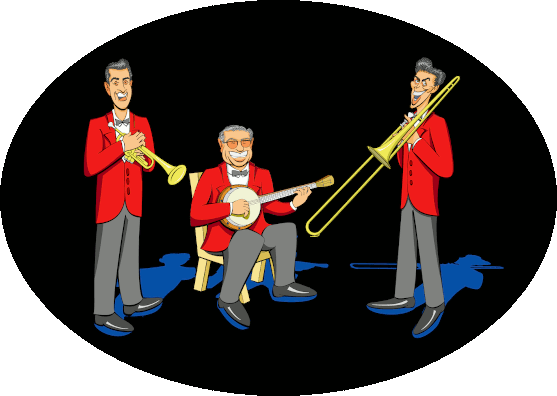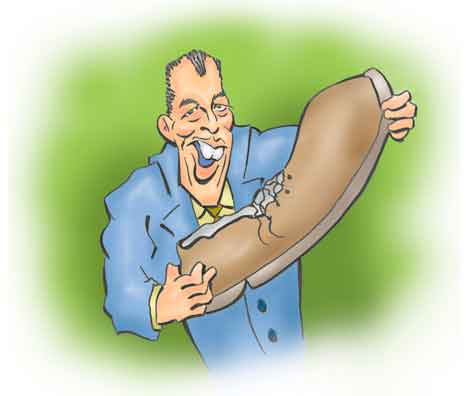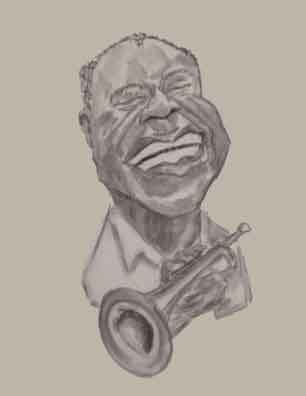
(Click to zoom in and out.)
| Zoot said he liked the way the Dukes of Dixieland played at the Monterey Jazz Festival one year. Two or three other musicians jumped on him, demanding to know how he possibly could like their music. "Well, you know me", Zoot said. "I haven't got very good taste. | |
| - | Bill Crow, Jazz Anecdotes, Oxford University Press, 1990. |
Much like the Kingston Trio for folk music, the very success of the original Dukes of Dixieland pretty much guaranteed they would be dismissed by the more serious jazz enthusiasts. After all, if something's popular, it can't be that good.
But the Dukes of Dixieland were popular, dang it! In fact, from the late 1950's up to the mid-60's they were arguably the most popular jazz band in the world. So the Three Assuntos - later it was four after vocalist Betty Owens married into the family - had not only created a family business, but it was a successful family business.
Despite the condescension of the, well, let's say the less "commercial" players, the Dukes were the real thing. They were a homegrown product of New Orleans, and like many youngsters cutting their musical teeth, the brothers Freddie and Frank started off playing in their school's marching band. But as native New Orleaners, they found jazz was practically an inborn instinct. Early on trombonist Freddie, at a wizened 17 years, and trumpet playing Frank, a mature 14, together with whoever else they could pull in, began to play one night a week at a local seafood restaurant. In addition to the base pay of $3 apiece plus tips1 they were allowed to stuff themselves during the intermission.
Footnote
Not quite as chintzy as it sounds. Today that would be about equivalent to $30 not including the tips for four hours work. This was well over the minimum wage which was 40¢ an hour.
In the 1940's most amateurs were strictly prohibited from accepting any payment, but that didn't apply rigorously to teenage musicians. Despite their professional engagements, the brothers - with the approval of their mother Josephine and father Jacinto - entered the then ubiquitous "Amateur Hours". Then in 1949 the big band leader Horace Heidt2 came to New Orleans. The Assunto brothers' band - whose clarinet player was a fellow named Pete Fountain - won the contest and were allowed to go on tour with Horace. Once back home they paid their union dues and turned professional.
The Assunto's music, like most traditional jazz, was largely instrumental although Frank - once described as having a "Mel Tormé voice" - would take vocals. Early on Betty appeared with the group but gradually bowed out after she married Freddie and began raising a new generation of Assuntos. As the recordings attest, Betty had a pleasant but strong and bluesy contralto perfectly suited for jazz, and it's too bad she decided to drop from the professional circuit.
The band played under several names until it finally solidified - at the suggestion of their mom - as the alliterative and catchy Dukes of Dixieland. The reason for the "Dukes" moniker is that it distinguished them from the various "Kings" of jazz that were ubiquitous.3 Jacinto - known as Papa Jac - soon began to serve as the tenor banjoist and second trombone (he played both on "Mama Don't 'Low") and when it was clear Fred and Frank were onto something big, he dropped his job teaching in the New Orleans public schools to be a full time member of the band. With his business degree from Tulane, Papa Jac also handled the books and became the band's manager. The group soon proved popular and ended up having extended stays at nightclubs and hotels.
Footnote
It may have been a gentle tweak to his friends' collective noses that prompted Pete Fountain to brand his own group as "The Kings of Dixieland".
The Dukes had made recordings as early as 1951 for small regional labels and in 1953 they released some singles on Okeh. But change was in the air. By 1955 they had been playing in Vegas - even before the Age of Elvis this was THE place for performers - when Sidney Frey, the owner of a new recording company called Audio Fidelity, came along looking for new artists. He caught the Dukes' act and signed them to an exclusive contract.
It was a perfect example of being in the right place at the right time. The 1950's had seen the decline of the three-minute 78 "record player" and by mid-decade "stereo high-fidelity systems" were available that could automatically play a queue of long-playing albums for literally hours of listening pleasure. Although taking up as much room as a living room sofa and costing as much as an automobile4, stereos began taking their hold of American culture.
The Dukes' records were billed as "a study in High Fidelity sound" with the tag line "You Have to Hear It to Believe It!". The album covers were well-designed and usually showed the band in the middle of a spirited number.5 The records sold like hotcakes - or rather like hot boudin - and album distribution ultimately totaled over a million records. Later the Dukes recorded for Columbia, Decca, and RCA.
Footnote
The Dukes' performances were generally quite animated. Freddie in particular was quite vigorous in his motions. Papa Jac, when on trombone, was not far behind.
By the end of 1957 the Dukes were receiving national attention and within a few years enjoyed immediate name recognition. In 1961 Life Magazine ran a photograph of a young record producer and the caption casually mentioned he was listening to a reel-to-reel tape of the Dukes of Dixieland. No further explanation was needed. By then everybody knew who the Dukes of Dixieland were.
As the Swinging Sixties moved in, newspapers started featuring articles asking "You waiting around for the Dukes of Dixieland to return?" and noted when they appeared with a symphony orchestra. Magazines peppered ads for the Dukes' albums side-by-side with those of megastars - Perry Como, Dean Martin, Andy Williams, Julie Andrews, Johnny Mathis, Leontyne Price - not to mention more venerable performers like Luddy "Vanny" Beethoven, Johnny "Sebby" Bach, and Wolfy "Ammy" Mozart.
By then radio had fallen from its pinnacle as the #1 venue of sedentary entertainment of American culture to be replaced by THE TUBE. The Dukes made the rounds not just on TV specials or short series like Ring-A-Ding Rhythm!, Dixieland at Disneyland, and Jazz for Squares, but also on regularly scheduled programs like The Timex All-Star Jazz Show (hosted by John Cameron Swayze), The Patti Page Oldsmobile Show, and The Bell Telephone Hour, as well as "name" shows hosted by the likes of Garry Moore, Jimmy Dean, Dean Martin, and Mike Douglas. These were the biggies. And of course, the Dukes appeared on the BIGGIE of the Biggies, The Ed Sullivan Show where they put on a really big shew.

A Really Big Shew
And of course they played with Louis Armstrong and their collaboration was recorded in an album released in 1960. The session was also documented by photographs of Louie and Frank playing their duets. To insure a pronounced stereo effect, Louie and Frank were positioned about thirty feet apart and played into separate microphones. Among the visitors who dropped by was drummer Gene Krupa and trumpet man Dizzy Gillespie.

Louie
And even BIGGER show.
The Dukes organized their songs meticulously. Arrangements were crafted verbally rather than putting the music down on paper. The final arrangements were complex and intricate but well planned and easy on the ear, a modus musiciandi that certainly contributed to their popularity. In a typical song there would be a spirited introduction followed by featured solos and then the whole band would join in for a rousing finish.
The heyday of the original Dukes ended suddenly when Fred died in 1966 at age 36. Papa Jac soon left the group to return to teaching. Frank continued to lead the band with new personnel.
Frank played with a strong clear tone but without the blaring sound you sometimes hear in more traditional Dixieland. As the sixties blended into the seventies, he began to depart from the group's colorful but conservative sports coats and ties, and in keeping with the decade's new norms, he eschewed the smooth visage that had been de rigueur since the band's formative years. In the early 1970's a young and impressionable but scarcely naïve young man decided to take in the show at Al Hirt's club on Bourbon Street. With a cover charge at $7 it was a bargain. Well-versed in the Dukes' Audio Fidelity recordings, the young and impressionable but scarcely naïve young man was surprised to learn that the mustachioed and mutton-chopped leader of the first act was none other than the famous Frank Assunto who was now wearing what he called his "a-hunting-we-will-go" outfit.6 Sadly Frank lived only two more years and died unexpectedly in 1974, age 42.
Footnote
The clarinet player for these performances was Harold Cooper, who appeared with the original Dukes and was featured on some of the earlier albums. Small in stature but big in tone, Harold later played and recorded with Al Hirt. He died in 1978 a few years after Frank.
References and Further Reading
The Assunto Dukes.
"The Dukes of Dixieland", Jazz: The Essential Companion, Ian Carr, Digby Fairweather, and Brian Priestly, Paladin Grafton Books (Collins), 1987.
"Young Man with a Good Ear", Life Magazine, September 22, 1961, pp. 133-134.
"Midnight Merry-Go-Round", [Washington, D. C.] Evening Star, February 8, 1962, p. C-7, Chronicling America, Library of Congress.
"Seventh Annual Jackson 'Pops' Concert at Fairgrounds May 15th", The Lexington [Kentucky] Advertiser, May 4, 1961, p. 3, Chronicling America, Library of Congress.
"Other TV Highlights", [Washington, D. C.] Evening Star, July 27, 1961, p. B-11, Chronicling America, Library of Congress.
"The Dukes of Dixieland", Discogs.
"The Dukes of Dixieland", Discography of AmericnHistorical Recordings, University of California - Santa Barbara.
The Dukes of Dixieland, Internet Movie Data Base.
To Tell the Truth, Sonny Fox (guest host for Bud Collier), Jacinto Assunto (contestant), Ralph Bellamy (panelist), Julia Meade (panelist), Tom Poston (panelist), Betty White (panelist), Mark Goodson (producer), Bill Todman (producer), February 24, 1959, CBS, Internet Movie Data Base.
"What Is The Difference Between New Orleans and Chicago Dixieland Jazz?", Bruce Chidester, The Trumpet Blog, February 6, 2015.
"1978 - Harold Cooper", New Orleans History - Lake Pontchartrain
"Purchasing Power Today of a US Dollar Transaction in the Past", Measuring Worth.
"History of Federal Minimum Wage Rates Under the Fair Labor Standards Act, 1938 - 2009", Wager and Hour Division, US Department of Labor.